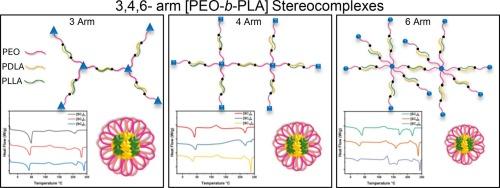定义明确的3、4和6臂星形聚(环氧乙烷)-b-聚(D或l-丙交酯)及其立体配合物
IF 6.3
2区 化学
Q1 POLYMER SCIENCE
引用次数: 0
摘要
星形聚(环氧乙烷)-b-聚(D或l -丙交酯)嵌段共聚物[PEO-b-PD/L-LA]x及其相应的立体配合物(SC)是具有许多潜在应用前景的两亲性材料。然而,由于EO和D/L-LA的聚合不相容,一锅法合成定义明确的[PEO-b-PD/L-LA]x仍然具有挑战性。此外,PLA的分子量和臂数对其热性能和胶束性能的影响还有待研究。本文报道了采用开环聚合(ROP)和催化剂切换策略,在一锅中合成了[PEO-b-PD/L-LA]x (x = 3,4,6),得到了具有窄分子量分布的多功能引发剂的星型[PEO-b-PD/L-LA]x嵌段共聚物。以含3、4、6个伯羟基的多功能引发剂和磷腈基t-BuP4为催化剂,引发EO的ROP。通过加入磷酸二苯酯来中和碱,加入Sn(Oct)2来促进[PEO]x大引发剂的LA的ROP,在一个锅中得到[PEO-b- pla]x。在二氯甲烷(DCM)中混合等量的具有相似分子量和臂数的[PEO-b- pdla]x和[PEO-b- plla]x,然后在室温下缓慢蒸发DCM,制备聚丙交酯立体配合物。采用1H NMR、粒径隔离色谱(SEC)、圆二色(CD)、傅里叶变换红外(FTIR)光谱、差示扫描量热法(DSC)、热重分析(TGA)、x射线衍射(XRD)光谱、动态光散射(DLS)、透射电子显微镜(TEM)、小角x射线散射(SAXS)、偏振光光学显微镜(PLOM)。聚乳酸的分子量和臂数对聚乳酸的热性能和胶束性能有重要影响。本文章由计算机程序翻译,如有差异,请以英文原文为准。

Well-defined 3, 4 and 6-arm star-shaped poly(ethylene oxide)-b-poly(D or L-lactide) and their stereocomplexes
Star-shaped poly(ethylene oxide)-b-poly(D or L-lactide) block copolymers, [PEO-b-PD/L-LA]x, and their corresponding stereocomplexes (SC) are amphiphilic materials with many potential applications. However, the one-pot synthesis of well-defined [PEO-b-PD/L-LA]x remains challenging due to the incompatibility between the polymerization of EO and D/L-LA. In addition, the effect of PLA molecular weights and the number of arms on their thermal and micellar properties has yet to be investigated. Herein, we report the synthesis of [PEO-b-PD/L-LA]x (x = 3, 4, 6) in one pot by using ring-opening polymerization (ROP) and a catalyst switch strategy to obtain star [PEO-b-PD/L-LA]x block copolymers with multifunctional initiators with narrow molecular weight distributions. ROP of EO was initiated by using multifunctional initiators (containing 3, 4, and 6 primary OH groups) and phosphazene base t-BuP4 as the catalyst. The base was neutralized by the addition of diphenyl phosphate, and Sn(Oct)2 was added to promote the ROP of LA from [PEO]x macroinitiators to afford [PEO-b-PLA]x in one pot. Polylactide stereocomplexes were prepared by mixing equal amounts of [PEO-b-PDLA]x and [PEO-b-PLLA]x having similar molecular weights and numbers of arms in dichloromethane (DCM), followed by slow evaporation of DCM at room temperature. The molecular structure, thermal and micelle properties of the [PEO-b-PD/L-LA]x and their SCs were characterized using 1H NMR, size exclusion chromatography (SEC), circular dichroism (CD), Fourier transform infrared (FTIR) spectroscopy, differential scanning calorimetry (DSC), thermal gravimetric analysis (TGA), X-ray diffraction (XRD) spectroscopy, dynamic light scattering (DLS), Transmission Electron Microscopy (TEM), Small Angle X-ray scattering (SAXS), and Polarized Light Optical Microscopy (PLOM). The molecular weights of PLA and the number of arms play significant roles in the thermal and micellar properties of the SC.
求助全文
通过发布文献求助,成功后即可免费获取论文全文。
去求助
来源期刊

European Polymer Journal
化学-高分子科学
CiteScore
9.90
自引率
10.00%
发文量
691
审稿时长
23 days
期刊介绍:
European Polymer Journal is dedicated to publishing work on fundamental and applied polymer chemistry and macromolecular materials. The journal covers all aspects of polymer synthesis, including polymerization mechanisms and chemical functional transformations, with a focus on novel polymers and the relationships between molecular structure and polymer properties. In addition, we welcome submissions on bio-based or renewable polymers, stimuli-responsive systems and polymer bio-hybrids. European Polymer Journal also publishes research on the biomedical application of polymers, including drug delivery and regenerative medicine. The main scope is covered but not limited to the following core research areas:
Polymer synthesis and functionalization
• Novel synthetic routes for polymerization, functional modification, controlled/living polymerization and precision polymers.
Stimuli-responsive polymers
• Including shape memory and self-healing polymers.
Supramolecular polymers and self-assembly
• Molecular recognition and higher order polymer structures.
Renewable and sustainable polymers
• Bio-based, biodegradable and anti-microbial polymers and polymeric bio-nanocomposites.
Polymers at interfaces and surfaces
• Chemistry and engineering of surfaces with biological relevance, including patterning, antifouling polymers and polymers for membrane applications.
Biomedical applications and nanomedicine
• Polymers for regenerative medicine, drug delivery molecular release and gene therapy
The scope of European Polymer Journal no longer includes Polymer Physics.
 求助内容:
求助内容: 应助结果提醒方式:
应助结果提醒方式:


